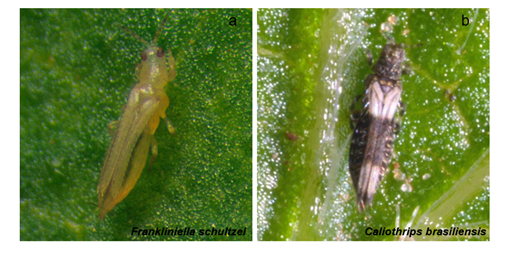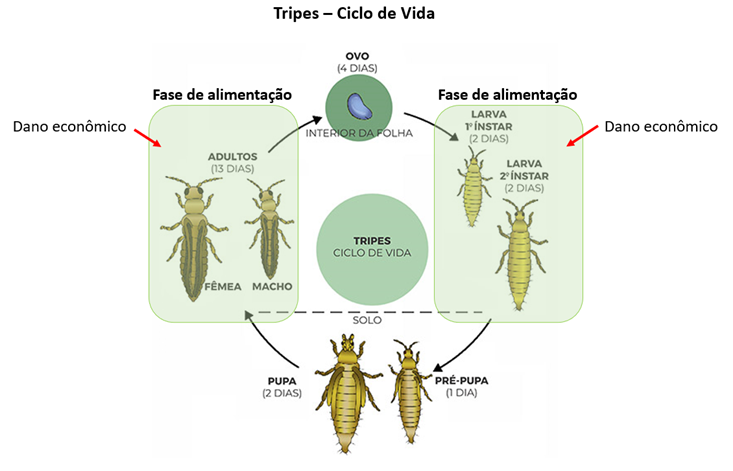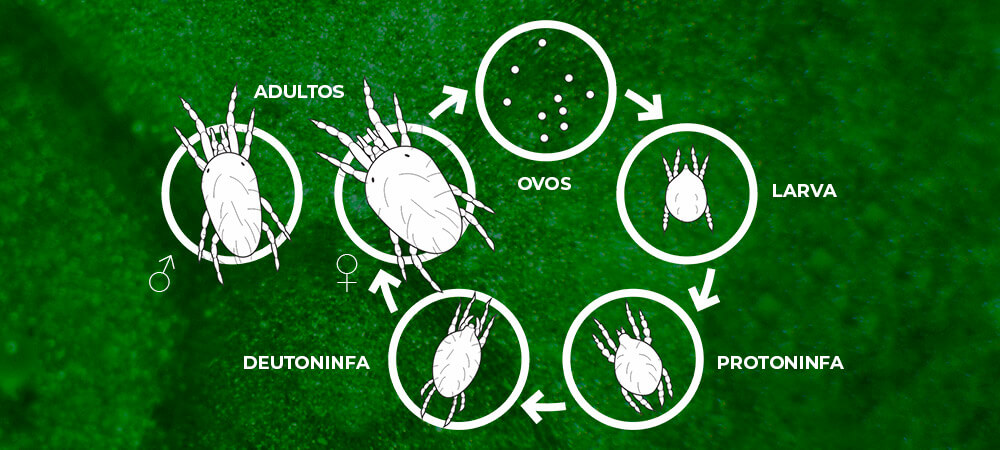What are thrips and mites?
1 - Thrips
They are small insects (1 – 3 mm), with a narrow body, with wings that allow them to move over small distances (Figure 1). They have a scraper mouthpiece, which damages the leaf's epidermis. The main agent for dispersing the pest over longer distances is the wind.

Figure 1 – Thrips species predominant in the soybean crop.
Its population increases in a few days, so rapid treatment and constant observation are essential to prevent its spread. The cycle of formation of new individuals is very fast, varying with environmental conditions, with the appearance of new adults within 5 to 10 days (Figure 2). It is noteworthy that among the development stages, only two occur economic damage, being in the larva or nymph stage and in the adult stage.

Adapted from: Promip, 2019
Figure 2 – Thrips life cycle scheme.
2 – Mites
They are tiny arachnids, measuring between 0.3 to 1 mm. The feeding process occurs through the introduction of stylets into plant cells and ingestion of extravasated intracellular content. The main form of dispersion is by the wind, but they also move between the plants, by walking.
The main species observed are the green mite (Mononychellus planki), the spotted mite (Tetranychus urticae), the white mite (Polyphagotarsonemus latus) and the red mite (Tetranychus ludeni, Tetranychus desertrum and Tetranychus gigas).

Figure 3 – Main species of mites causing damage to crops.
a) Green mite (Mononychellus planki);
b) Spotted spider mite (Tetranychus urticae);
c) White mite (Polyphagotarsonemus latus);
d) Red mites (Tetranychus spp.)
Source: Agrolink Portal
The cycle of T. urticae (Figure 4) varies on average from 11 to 20 days, however, the higher the temperature, the faster its development occurs. Under optimal temperature conditions (28 to 32°C) they complete the cycle in a week, rapidly increasing the population and infesting the crop.

Figure 4 – Life cycle of the spider mite (Tetranychus urticae) Source: Promip, 2019.
Mites generally feed on several plants, with more than 150 different species of plants of economic importance occurring in the world.
The population increase is favored by low rainfall, especially in the reproductive phase of the crop and by spraying some fungicides and insecticides. Biological control agents such as predatory mites (beneficial mites) and diseases such as the fungus Neozygites floridana are commonly associated with pest mites.
What crops do they attack and what damage is caused?
Thrips occur in a variety of crops, from vegetables to commercial grain crops. They usually live on leaves, shoots, flowers and under the bark of trees. The most common damage observed in soybean crops are wrinkled leaves with a green color punctuated by small whitish spots, as well as being vectors of viruses (smoke-burning).
Mites are easily found in the vegetative and grain-filling stage. These small organisms feed on soy leaf cells, reducing photosynthesis and the plant's energy production. In cases of severe attack, they cause anticipation of senescence and leaf fall, which may lead to a reduction in crop productivity, in extreme cases.
Both pests promote the formation of white spots on the leaves, which evolve to tan, necrosis and premature shedding. Furthermore, they affect the plant's ability to carry out photosynthesis, in addition to the loss of water in the attacked areas.
What conditions favor its development?
Both thrips and mites are favored by environmental conditions of low precipitation.
Integrated pest management
Monitoring is essential for the integrated management of these two pests. When identified during the beginning of infestations, management becomes easier and less costly for the producer.
Control measures start with prevention, avoiding the indiscriminate use of insecticides (pyrethroids and neonicotinoids) and fungicides, as these also eliminate natural enemies, favoring population growth.
When populations reach the level of economic damage, other control strategies must be adopted. The main one is chemical management, since there are few options for biological products with an effect on these pests, or even they are unfeasible for large areas, such as commercial crops.
For thrips, the most effective insecticides are those recommended for scrapers/suckers, and the association of active ingredients favors control performance, in addition to one of the products having translaminar action. For mites, use the acaricides recommended for the culture.
Conclusion
Thus, it is necessary to constantly monitor crops, especially in dry periods, as these pests are favored under these conditions. Despite being small, difficult to see and identify, they have the potential for economic damage, mainly due to reduced photosynthesis, water loss and premature leaf fall, requiring specific interventions for control.




